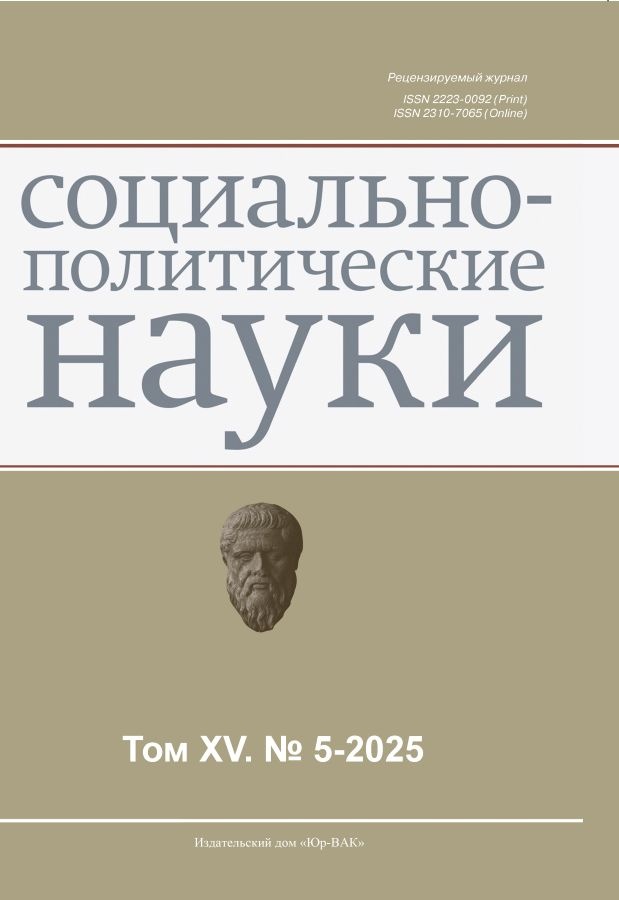Public-private Partnership in the Interaction of Government and Business (Using Sports Infrastructure as a Case Study)
- 作者: Ilyicheva L.E.1,2, Ovanesyan A.A.2
-
隶属关系:
- Institute of Public Administration and Civil Service of the Russian Presidential Academy of National Economy and Public Administration
- Federal Center of Theoretical and Applied Sociology of the Russian Academy of Sciences
- 期: 卷 15, 编号 5 (2025)
- 页面: 76-87
- 栏目: Political Institutions, Processes and Technologies
- URL: https://journals.eco-vector.com/2223-0092/article/view/696686
- DOI: https://doi.org/10.33693/2223-0092-2025-15-5-76-87
- EDN: https://elibrary.ru/DQOUET
- ID: 696686
如何引用文章
详细
The article examines the forms, features, and legal foundations of public-private partnership (PPP) as an institutional framework for interaction between the state and business in project implementation. Particular attention is given to the legal and regulatory framework governing PPPs in Russia, as well as the management mechanisms that enhance the efficiency of partnership projects. The study analyses key challenges in public-private interaction, such as diverging interests, institutional constraints, and regulatory gaps. The empirical part of the article focuses on case studies of sports infrastructure projects. The author emphasizes the importance of a comprehensive legal and organizational approach to PPPs as a tool for developing social infrastructure.
全文:
作者简介
Lyudmila Ilyicheva
Institute of Public Administration and Civil Service of the Russian Presidential Academy of National Economy and Public Administration; Federal Center of Theoretical and Applied Sociology of the Russian Academy of Sciences
编辑信件的主要联系方式.
Email: lilitcheva@mail.ru
ORCID iD: 0000-0002-0223-6418
Dr. Sci. (Polit.), Professor, Director, Public-private Partnership Center; chief researcher, Institute of Socio-Political Research
俄罗斯联邦, Moscow; MoscowAlisa Ovanesyan
Federal Center of Theoretical and Applied Sociology of the Russian Academy of Sciences
Email: alya.ovanesyan@mail.ru
extern
俄罗斯联邦, Moscow参考
- Abrahamyan S.K., Golubkina K.V. Organizational and legal forms of PPP-based projects, Humanities, Socio-economic and Social Sciences. 2020. No. 7. (In Rus.). doi: 10.23672/a4036-0587-2372-1.
- Aldoshina E.A., Aldoshin A.V., Ivanina L.I. Mechanisms for the development of public-private partnership in sports infrastructure. OSU Scientific Notes. Series: Humanities and Social Sciences. 2015. No. 2. Pp. 247–249. (In Rus.)
- Boychuk A.V. Investment mechanisms of public-private partnership. Progressive Economics. 2024. No. 7. (In Rus.). doi: 10.54861/27131211_7_33.
- Borisova L.A., Ismailova F.N. Basic forms and models of project implementation. Bulletin of the Altai Academy of Economics and Law. 2024. No. 9 (Part 1). Pp. 45–50. (In Rus.). doi: 10.17513/vaael.3696.
- Vedernikova E.V. Analysis of the state of public-private partnership in Russia. Bulletin of PNRPU. Socio-economic Sciences. 2023. No. 2. Pp. 242–253. (In Rus.). doi: 10.15593/2224-9354/2023.2.17.
- Ilyichev M.V. A method for assessing the effectiveness of asset allocation in solving the problem of forming a coalition structure in the economic system using the example of the metallurgical industry. Finance, Money, Investments. 2022. No. 3 (83). Pp. 24–34. (In Rus.). doi: 10.36992/2222-0917_ 2022_3_24.
- Ilyicheva L.E., Komarovsky V.S. The subject field of economic political science. Monograph. Moscow: Aspect Press, 2018. 240 p. ISBN: 978-5-7567-0984-1.
- Kurgan A.A. Reasons hindering the development of the Institute of public-private partnership (PPP) in the regions. Forum of Young Scientists. 2024. No. 12 (100). (In Rus.)
- Maslova S.V., Eremin V.V. Problems of legal regulation of public-private partnership in Russian legal research before and after the adoption of the Federal Law on public-private partnership. Part one. Bulletin of St. Petersburg State University. Series 14: Law. 2023. No. 1. Pp. 141–158. (In Rus.). doi: 10.21638/spbu14.2023.109.
- Merzlov I.Yu. Private initiative in public-private partnership projects: A conceptual view. The World of Economics and Management. 2023. No. 23 (4). Pp. 121–135. (In Rus.). doi: 10.25205/2542-0429-2023-23-4-121-135.
- Parushev A.V. Public-private partnership as an effective way to develop physical culture and sports in Russia. Economics, Entrepreneurship and Law. 2023. Vol. 13. No. 11. Pp. 4729–4730. (In Rus.). doi: 10.18334/epp.13.11.119499.
- Protopopova N.I. Public-private partnership as an institution for coordinating the economic interests of the state and private capital (the paradigm of the Institute of PPP). Bulletin of TIUE. 2011. No. 2. P. 16. (In Rus.)
- Savchenko Ya.V., Mikhailova N.S. The life cycle contract model in public-private partnership projects in the field of physical culture and sports. Russian Journal of Entrepreneurship. 2017. No. 24. Pp. 4250–4253. (In Rus.). doi: 10.18334/rp.18.24.38597.
- Skifskaya A.L., Mehrishvili L.L., Shestakov S.A. Formation and development of public-private partnership. Bulletin of Universitys. Sociology. Economy. Politics. 2023. No. 3. (In Rus.)
- Sleptsova E.V., Tsaturyan A.A. Prospects for the development of public-private partnership in Russia. Economics and Business: Theory and Practice. 2023. No. 4-2 (98). Pp. 150–152. (In Rus.). doi: 10.24412/2411-0450-2023-4-2-150-152.
- Delmon J. Private sector investment in infrastructure: Project finance, PPP projects and risk. The World Bank and Kluwer Law International, 2009. P. 7.
补充文件








